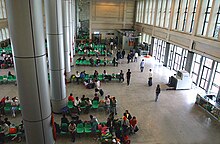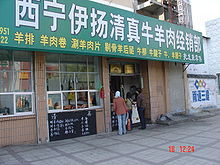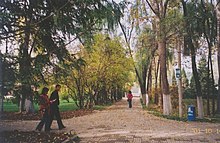Xining

Xining (Simplified Chinese : 西宁, Traditional Chinese : 西寧, Tibetan : ཟི་ནིང་; Pinyin : Xīníng, Wylie: Zi-ning) is the capital of Qinghai Province, People's Republic of China.
Geography

Xining is located in the eastern part of Qinghai province and lies on the HuangShui River(湟水河). It has a total area of 350 km². Xining is located on the eastern edge of Qinghai-Tibet Plateau and the upper reaches of Huangshui River. It is the political, economic, scientific and technological, cultural and traffic center of Qinghai Province with an average altitude of over 2200 meters (about 7217 feet). The activities of human beings in this region can be traced to 2,100 years ago. During the Western and Eastern Han Dynasties, owing to its developing agriculture, Xining was paid more attention due to its economic and martial significance. As well as being the important hinge between the central plains and the western part of China in ancient time, Xining was the most common passing channel of the famous Silk Road. Until now, it is still the only road by which to enter the hinterland of the Qinghai-Tibet Plateau.
At present, five districts, three counties and a national economic and technological development zone are under the administration of the local government. With a population of more than two million, Xining is the first city on the upper reaches of the Yellow River to achieve a population into the millions. There are about 37 nationalities living here, including Han, Hui, Tu and Tibetan. The local traditions and customs are influenced by these distinctive nationalities, in particular the Tibetan group.
Xining is also called the Summer Resort Capital of China for its cool summer. The region also provides a number of attractions making a visit to the area well worth considering. The scenery of the Qinghai Lake, situated within Xining, provides an escape from fervent cities and allows you to experience beautiful natural sceneries. The Birds Island, situated on the northwest of Qinghai Lake, is waiting to present you with an extensive array of birds. To the southwest of Xining, is the birthplace of the founder of the Gelugpa Sect. The gem of the Tibetan culture-Ta'er Monastery was built here. To the north of Xining is the Beichan Temple. Climbing the temple will reward you with a view of the city from the mountaintop. A site not to be missed is the Dongguan Mosque, one of the biggest mosques in northern China.
For most visitors both home and abroad, Xining provides a variety of delicious food and snacks. You can find some special meat products easily here for Xining is also a pasturing area. But, at the same time, don't forget that your health should be put on the first position. The popularity of the Xining region has been enhanced by convenient transportation and accommodation.
Tourism

Located in the southwest part of Xining City, the Ta'er Monastery is one of six famous monasteries in the Gelug (also called Yellow Hat Sect) of Tibetan Buddhism. There are convenient ways to get there, e.g., take the No. 1 bus from the Xining Railway Station to Xi Men. From there you can take a half-hour taxi ride (up to four people can share a cab) to the monastery. Additionally, regular buses are available and take about an hour from the railway station. The cost of each bus ride is CNY5 per person.
Having a history of over 600 years, the Dongguan Mosque, located in the Xining City Zone, is one of the most famous mosques in the northwest region of China. Many visitors are fascinated by the splendid and diversiform towers, walls and halls in the mosque. The Nos. 1, 2, and 23 buses will take you directly there. Please note that visitors are allowed during Moslem prayer sessions.
Another unique religious structure with intoxicating views is the Beishan Si (North Mountain Temple), a Taoist facility. It costs about CNY4 to get there from Xining by taxi. The Nos. 19, 21, 80, 84 and 107 buses can also take you to the temple.
The Xining region is also replete with natural scenic attractions. One is the Sun and Moon Mountain which divides Qinghai Province into two parts - the stock-raising area and the farming area. Another not-to-be-missed destination is the Qinghai Lake and Bird Island. This alluring body of water is home to hundreds of thousands of birds. About 35 kilometers west of Xining City in Datong County, you can experience the magical power of Laoye Mountain. Every year on the 6th day of the 6th lunar month, the traditional singing festival attracts hundreds of thousands of visitors.
Food

As the capital of Qinghai Province, Xining almost boasts all varieties of local flavors. Xining's cuisine is distinct from other varieties of Chinese cities using mainly food products native to the area. Only in Xining can you sample the tasty local flavors and snacks. Food here is substantial, but happily quite inexpensive.
Local Snacks
A unique feature of snacks in Xining is that they are given names after the surname of their initiator. Some of the famous ones will be introduced in next context.
Liangfen (bean jelly) is made from pea powder and cut into short strips. Liangfen is served with vinegar, chili and mashed garlic, mustard and salt to enhance the taste the dish.
Niangpi is a popular snack made of flour and baking soda. It can be found anywhere in Xining for four-yuan. The most famous version of this snack is called Mazhong Niangpi and can be found in the Mojia Jie.
Zasui Tang is a soup cooked with lamb and oxen entrails.[citation needed] Locals often eat this snack for breakfast. The hot soup helps warm people during the winter.
Muslim Yoghurt is a must while in Xining[citation needed] – this breakfast is a kind of yoghurt made by local Muslim families and is served in small bowls for one-yuan.
Terrine is a popular and inexpensive snack in Xining. It is a small hot pot which contains beef, mutton, been curd and vermicelli.
Mutton Eaten with Fingers is the most famous snack in Qinghai Province.[citation needed] It is made of fresh mutton and served with a little salt. This snack is the favorite food of the herdsmen of Qinghai Province.
Dishes of Plateau Flavor
In Xining, some fancier restaurants serve varieties of 'plateau flavor', such as Feng'er Liji (a round lamb tenderloin), Danbai Chongcao Ji (a medicine cuisine made of chicken, Chinese caterpillar fungus and eggs), Jinyu Facai (pork wrapped in flabelliform nostoc and shaped as a goldfish) among others. These dishes are often cooked by the locals at home. Below are a variety of recommendations:
Muslim Da Ximen Restaurant Specialties: Moslem cuisines Address: No.120, Changjiang Lu, Middle District of Xining Bus Route: 18, 19, 21, 27 Opening Hours: 10:00-22:00
Zhongfayuan Restaurant Address: No.1, Shulin Xiang, Dongguan Dajie, Eastern District of Xining Bus Route: 1, 2, 22
Xiao Yuanmen Restaurant Address: No.190, Donguan Dajie, Xining Bus Route: 1, 2, 23, 25 Opening Hours: 9:30-23:00
Western Food Restaurants
While some of the hotels in Xining have western food services (such as the 28th Floor Rotary Western Restaurant that sits atop the city and allows diners to enjoy the view as well as the food, located at No.55 Xi Dajie), Xining's best western food may be found at the Italian restaurant "Casa Mia" located near Qinghai Normal University (Qinghai Shifan Daxue, or Shida).
Fast Food
There are three branches of KFC in Xining. Address: N0.53, Dong Dajie No.40, Xi Dajie The first floor of Wantong Center, Wusi Dajie
There are a couple branches of an Australian Fast Food chain called Dico's. It's a lot like KFC.
Demographics

As of 2006, the total population of Xining is approximately 2,095,000, with an urban population of 1,029,400.
Night life
Xining has a vivid nightlife as streets are filled with small venders selling both food and clothing. It's best to try all the food sold at small venders at night, since they are enriched with the flavours of the northern part of China. Many young people may party at famous KTV houses and at various night-bars and clubs. The older people will be seen at the coffee houses and tea houses.
Economy
The GDP per capita was ¥6676.12 (ca. US$844) in 2005, ranked no. 382 among 659 Chinese cities. Its main industries are wool spinning and textiles, fur, meat, milk, salt, and light processing industries. Another popular activity is Tibetan dancing in Xining Square.
History

Xining has a history of over 2100 years[1] and was a chief commercial hub on the Hexi Corridor caravan route to Tibet, handling especially timber, wool and salt in ancient times.
Xining was the extraterritorial capital of the Koko Nor territory and remained in Gansu until 1928, when it became the capital of the newly formed Qinghai province.
Construction of a highway to the mineral-rich Qaidam basin and completion in 1959 of a link to the Chinese rail network via Lanzhou in Gansu province has spurred industrial development.
Colleges and universities
Public
- Qinghai University (青海大学)
- Qinghai Normal University (青海师范大学)
- Qinghai Medical College (青海医学院)
- Qinghai University for Nationalities (青海民族学院)
Note: Institutions without full-time bachelor programs are not listed.
Xining earthquake
The earthquake occurred May 22, 1927 and measured 8.6 on Richter scale. It was one of the deadliest earthquakes with a total count of 200,000 deaths. It also caused large land fractures.
Further reading
- A. Gruschke: The Cultural Monuments of Tibet’s Outer Provinces: Amdo - Volume 1. The Qinghai Part of Amdo, White Lotus Press, Bangkok 2004. ISBN 974-480-049-6
- Tsering Shakya: The Dragon in the Land of Snows. A History of Modern Tibet Since 1947, London 1999, ISBN 0-14-019615-3
